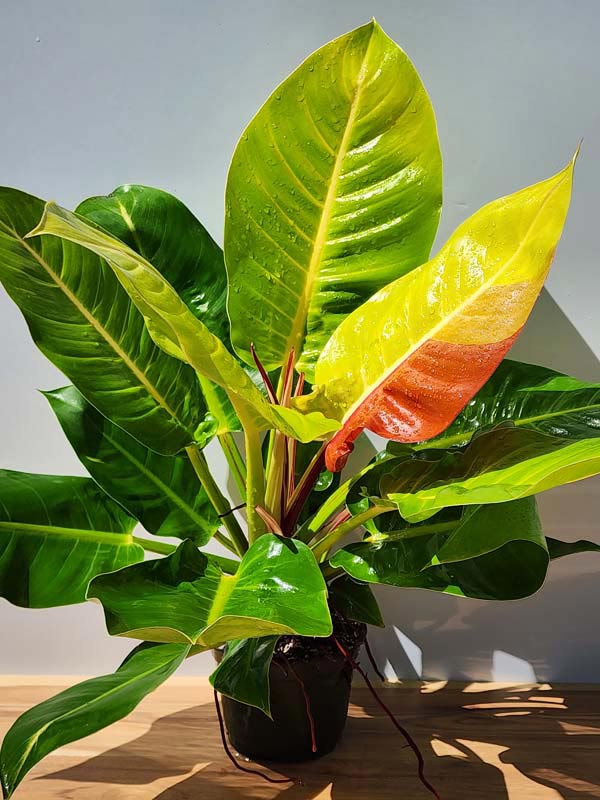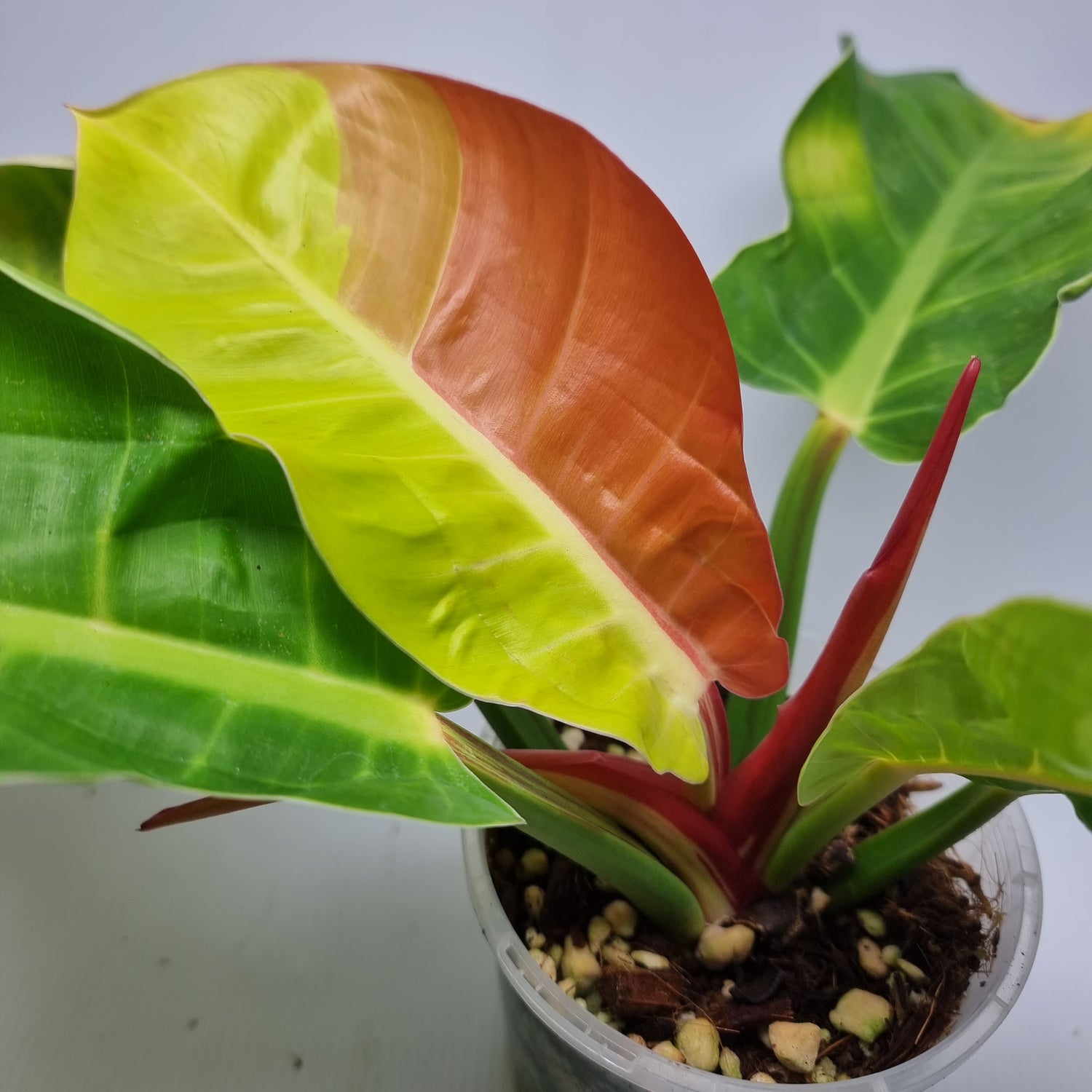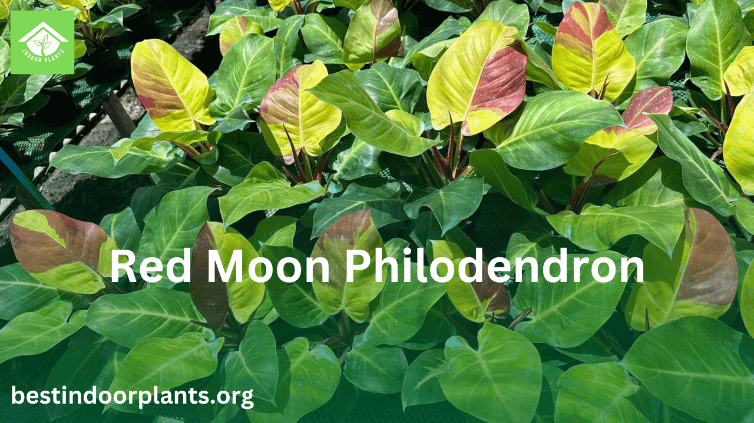Philodendron Red Moon is an exotic indoor plant that has won the hearts of many garden enthusiasts. The bright red and green leaves make it a spectacle in any indoor garden. This comprehensive guide to growing a Red Moon Philodendron indoors will take you through everything from understanding its unique characteristics to mastering its care.
Introduction to Red Moon Philodendron
What is a Red Moon Philodendron?
The foliage on this hybrid variety showcases deep red, lush green, or sometimes yellow colors, making it very attractive. It’s also one of the rare varieties highly sought by collectors and plant enthusiasts.

Origins and Varieties
Red Moon Philodendron falls under the Araceae family and belongs to the genus Philodendron that comprises more than 400 species. This particular type is valued for its great coloration which makes it easily manageable hence many people consider it for indoor décor.
Benefits of Growing a Red Moon Philodendron
Why Should You Grow a Red Moon Philodendron?
Aesthetics
The vibrant red and green leaves of this species add life and color into every room they are placed in. Thus, if your home features modern designs that incorporate either climbing or trailing plants with unique colors then you can choose the above mentioned for decoration purposes.
Air freshener
Indoor environments can be improved by having houseplants as they clean out toxins among them formaldehyde and benzene thereby creating healthy habitat for us.
Low Maintenance
It is a plant suitable even for beginners since it requires minimum attention regarding watering frequency or lighting conditions of the place where it grows best when taken good care of; otherwise, there could be some changes in color as well as shape over time in response to environmental factors like temperature variations between day time versus night periods (Wertz et al 2016).
Stress Relief
Caring for plants reduces stress levels according to research findings. Engaging with this particular plant can help individuals feel relaxed and happy; thus leading to improved quality of life.
Educational Value
In addition, growing this type of plant offers a chance to learn about propagation methods, biology and care. It is also an opportunity for hands-on learning about horticultural practices.
Increased Humidity
Through transpiration, red moon philodendron adds moisture into the surrounding air. This may be beneficial in case of low humidity indoors especially during dry seasons which are common in certain areas or colder months when windows cannot be left open all day long.
Flexible Placement
It can be put anywhere within a house, either where there is bright indirect sunlight or less lit up corners. This adaptability makes it perfect for different rooms.
Unique Collector’s Item
The uniqueness in appearance attracts collectors because it looks like no other species known so far. Moreover, its appearance alone can serve as an icebreaker during social events.
Home Improvement
Some high quality indoor plants such as this one have been known to enhance the aesthetic value of houses thereby increasing their market worth.
Personal satisfaction
Caring well for a Red Moon Philodendron brings fulfillment and enjoyment into your daily life as you achieve something from it.
Difference between Red Moon and Red Sun Philodendron
Red Moon Philodendron
- Foliage: Colored red and green usually with some yellowish coloration at times.
- Growth Habit: Climbing or trailing habit needs support as it grows upwards towards light source while that overhangs root system below ground level through branches above them too!
- Light Requirements: Wants bright but indirect light throughout its growth stages starting off early seed stage till matured adult period within couple years!
Red Sun Philodendron
- Foliage: Bright new reddish leaves that mature to green.
- Growth Habit: Baby getting bigger and taller day by day with a wonderful shape.
- Light Requirements: It likes bright indirect light but will survive under lower light conditions as well.
- Care Tips for Red Moon Philodendron
Light Requirements.
This tropical plant prefers bright, indirect sunlight. Exposure to direct sunlight results in scorched leaves; while the leaves lose their vibrant colors in low-light situations. Place it near or around windows where the sun is filtered through sheer curtains or blinds.
Watering
Ensure that you keep the soil consistently moist but not soggy wet. Water when its top inch of soil becomes dry. Over-watering would result in root rot, therefore ensure that the pot has good drainage.
Humidity and Temperature
The Red Moon Philodendron does best in a humid climate. Regular misting and placing on a humidity tray can help you maintain moisture levels. This species thrives at temperatures between 65-80°F (18-27°C). Do not allow air drafts brought about by open windows or cold air conditioning systems to touch it during winter months.
Soil and Fertilization
Use a well-drained growing media like peat moss, perlite, and pine bark mixtures. For optimal growth rates apply balanced liquid fertilizer diluted to half strength every month during spring and summer seasons. Reduce feeding when growth slows down during fall and winter months.

Propagation Techniques
Stem Cuttings
For Red Moon philodendrons stem cuttings are commonly used:
- Select a Healthy Stem – Choose a stem with at least two nodes having healthy leaves attached to them.
- Cut Below a Node – Use clean knife or scissors to cut below node section close to where leaf petiole is attached on the steam surface.
- Prepare the Cutting – Take off all lower leaves leaving only two remaining at the top of the cutting.
- Root in Water or Soil – Either place the cutting in a glass with water or straight into pot with moist potting mix. Ensure that you change water regularly if rooting in water.
Air Layering
On larger plants, air layering is an effective technique:
- Select a Stem – This should be a healthy stem and make a small incision halfway through it.
- Insert a Toothpick – Use the toothpick to keep the cut open.
- Wrap with Moss – Sphagnum moss is to be soaked before being wrapped around the cut followed by plastic wrapping then secure it with tying material or tape.
- Wait for Roots – After few weeks, roots should have started growing out. Cut below these new roots and put them on soil to form new plants.
Common Issues and Solutions
Although growing Red Moon Philodendron is very rewarding, like all plants, it can face some problems. Here are some common issues you may encounter and what to do about them:
Yellowing Leaves
Cause: Too much watering or not enough drainage
Solution:
- Check Soil Moisture: Allow top inch of soil to dry out between watering schedules for this plant.
- Improve Drainage: Ensure there are holes on your pot. When water fills up in the saucer, empty it occasionally.
- Adjust Watering Schedule: Withhold water more often ensuring that soil remains slightly wet only.
Brown Leaf Tips
Cause: Lack of humidity or insufficient watering
Solution:
- Increase Humidity: You could use humidifiers, install humidity trays containing pebbles filled with water under pots or just mist leaves frequently using sprayers specifically made for such purposes.
- Consistent Watering: Regularly check that your plant does not get dried up because it needs enough water but not sogginess at any one time of its life cycle.
Leaf Curling or Drooping
Cause: Inadequate watering practices, excess moisture content within soil medium or temperature fluctuations
Solution:
- Check Watering Practices: Ensure you neither over-water nor under-water the plant. The soil should be moist but well-drained.
- Temperature Monitor: Keep the plant in a surrounding between 65-80°F (18-27°C) and away from drafts or heating vents.
Fading or Lack of Variegation
Cause: Insufficient Light
Solution:
- Increase Light Exposure: Move the plant to a brighter location with indirect light. Avoid direct sunlight, which can scorch the leaves.
- Supplement Light: If natural light is not enough, use grow lights for adequate illumination.
Pests
Common Pests: Spider Mites, Aphids, Mealybugs
Solution:
- Regular Inspection: Regularly check your plant for signs of pests, such as webbing (spider mites), sticky residue (aphids), or cottony masses (mealybugs).
- Isolation: When you spot any pests, isolate the affected plant to prevent spreading them.
- Treatment: Use insecticidal soap, neem oil or water mixed with dish soap on your plant. Apply as indicated normally every 7 – 10 days until there are no more pests.
Root Rot
Cause: Overwatering and Poor Drainage
Solution:
- Inspect Roots: Take out the plants from their pots and check on their roots. Healthy roots are white and firm while those rotten ones are brown and mushy.
- Trim Affected Roots: Using clean scissors trim off any rotten roots.
- Repotting : Then repot in fresh well-draining soil in a clean pot with proper drainage holes.
- Adjust Watering Frequency : Then water less frequently ensuring that the soil dries out between waterings each time.
Stunted Growth
Cause: Nutrient Deficiency or Poor Growing Conditions
Solution:
- Fertilize Regularly: For necessary nutrients during the growing season (spring and summer), use balanced water soluble fertilizer.
- Review Growing Conditions : Ensure adequate lighting for the plant; temperature is appropriate as well as watering procedure.
Leggy Growth
Cause: Insufficient Light
Solution:
- Increase Light Exposure: Move the plant to a location with more bright, indirect light.
- Pruning: Prune leggy stems in order to encourage bushier growth. Make cuts just above a leaf node in order to promote branching.

Philodendron Red Moon vs. Philodendron Yellow Flame
Philodendron Red Moon
- Foliage: Deep red and green variegation.
- Light Requirements: Bright, indirect light preferred
Philodendron Yellow Flame
- Foliage: Bright yellow leaves with green edges.
- Light Requirements : It needs bright indirect light for it to maintain its vibrant colors.
Frequently Asked Questions (FAQ) About Red Moon Philodendron
What is a Red Moon Philodendron?
The Red Moon Philodendron is a hybrid plant known for its striking foliage featuring mix of deep red, vibrant green and sometimes yellow which that is highly attractive due to its unique appearance and relative ease of care.
How do I care for a Red Moon Philodendron?
- Light – Provide bright, indirect sunlight.Light Avoid direct sunlight as this may scorch the leaves.
- Watering – Water when the top inch of soil feels dry.Water Ensure good drainage on the pot to avoid water logging it.
- Humidity- Preferably keep in a humid environment.A regular misting or humidify tray can do wonders too.
- Temperature – Maintain temperatures between 65-80°F (18-27°C).Avoid drafts and sudden temperature changes.Temperature Avoid drafts and sudden temperature change while maintaining 65-80 degrees Fahrenheit temperatures (18-27 Celsius).
How often should I water my Red Moon Philodendron?
Water when you feel that the upper most layer of soil has dried up or typically once per week but frequency may depend on lighting, temperature levels among others.Usually once a week or so but can go longer depending upon such factors as lighting conditions, temperature and humidity.
Can I grow Red Moon Philodendron outdoors?
Though it is mainly grown indoors, it can be grown outside in tropical or subtropical regions.The plant should however be placed in a shaded or partially shaded area to protect it from direct sunlight.
What are typical problems with Red Moon Philodendron and how can I solve them?
- Yellowing Leaves: This is normally caused by too much water. Allow the soil to dry out and ensure proper drainage.
- Browning Leaf Tips: Generally due to low humidity or under watering. Increase humidity and adjust watering practices.
- Pests: Some common pests include spider mites, aphids or mealybugs. Use insecticidal soap or neem oil for treatment.
In The End
Red Moon Philodendron is an amazing plant which adds beauty and colour to any indoor space. We hope that following the care tips and propagation techniques included in this guide will help your Red Moon Philodendron flourish into a stunning centerpiece in your home garden.
Whether you’re a green thumb with years of experience or a complete novice, having a Red Moon Philodendron is something that you’d definitely appreciate as it brings tropical elegance to your living areas. It’s not surprising that it has become one of the most beloved houseplants because of its attractive leaves and relatively low maintenance requirements.
